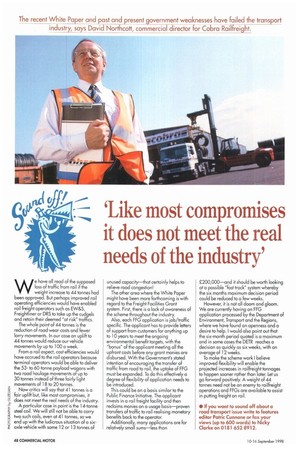The recent White Paper and past and present government weaknesses
Page 52

If you've noticed an error in this article please click here to report it so we can fix it.
have failed the transport industry, says David Northcott, commercial director for Cobra Rai'freight.
'Like most compromises it does not meet the real needs of the industry'
We have all read of the supposed loss of traffic from rail if the weight increase to 44 tonnes had been approved. But perhaps improved rail operating efficiencies would have enabled rail freight operators such as EW&S, Freightliner or DRS to take up the cudgels and retain their deemed "at risk" traffics.
The whole point of 44 tonnes is the reduction of road wear costs and fewer lorry movements. In our case an uplift to 44 tonnes would reduce our vehicle movements by up to 100 a week. From a rail aspect, cost efficiencies would have accrued to the rail operators because terminal operators would be able to deliver the 53to 60-tonne payload wagons with two road haulage movements of up to 30 tonnes instead of three fairly light movements of 18 to 20 tonnes.
Now critics will say that 41 tonnes is a fair uplift but, like most compromises, it does not meet the real needs of the industry. A particular case in point is the 14-tonne steel coil. We will still not be able to carry two such coils, even at 41 tonnes, so we end up with the ludicrous situation of a sixaxle vehicle with some 12 or 13 tonnes of unused capacity—that certainly helps to relieve road congestion! The other area where the White Paper might have been more forthcoming is with regard to the Freight Facilities Grant system. First, there is a lack of awareness of the scheme throughout the industry. Also, each FFG application is job/traffic specific. The applicant has to provide letters of support from customers for anything up to 10 years to meet the ongoing environmental benefit targets, with the "bonus" of the applicant meeting all the upfront costs before any grant monies are disbursed. With the Government's stated intention of encouraging the transfer of traffic from road to rail, the uptake of FFG must be expanded. To do this effectively a degree of flexibility of application needs to be introduced.
This could be on a basis similar to the Public Finance Initiative. The applicant invests in a rail freight facility and then reclaims monies on a usage basis—proven transfers of traffic to rail realising monetary benefits back to the operator. Additionally, many applications are for relatively small sums—less than £200,000—and it should be worth looking at a possible "fast track" system whereby the six months maximum decision period could be reduced to a few weeks.
However, it is not all doom and gloom. We are currently having an FFG application processed by the Department of Environment, Transport and the Regions, where we have found an openness and a desire to help. I would also point out that the six-month period quoted is a maximum and in some cases the DETR reaches a decision as quickly as six weeks, with an average of 12 weeks. To make the scheme work I believe improved flexibility will enable the projected increases in railfreight tonnages to happen sooner rather than later. Let us go forward positively. A weight of 44 tonnes need not be an enemy to railfreight operations and FFGs are available to assist in putting freight on rail.
• If you want to sound off about a road transport issue write to features editor Patric Cunnane or fax your views (up to 600 words) to Nicky Clarke on 0181 652 8912.
















































































































